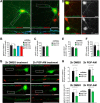Endosomal Phosphatidylinositol 3-Phosphate Promotes Gephyrin Clustering and GABAergic Neurotransmission at Inhibitory Postsynapses
- PMID: 27941024
- PMCID: PMC5270463
- DOI: 10.1074/jbc.M116.771592
Endosomal Phosphatidylinositol 3-Phosphate Promotes Gephyrin Clustering and GABAergic Neurotransmission at Inhibitory Postsynapses
Abstract
The formation of neuronal synapses and the dynamic regulation of their efficacy depend on the proper assembly of the postsynaptic neurotransmitter receptor apparatus. Receptor recruitment to inhibitory GABAergic postsynapses requires the scaffold protein gephyrin and the guanine nucleotide exchange factor collybistin (Cb). In vitro, the pleckstrin homology domain of Cb binds phosphoinositides, specifically phosphatidylinositol 3-phosphate (PI3P). However, whether PI3P is required for inhibitory postsynapse formation is currently unknown. Here, we investigated the role of PI3P at developing GABAergic postsynapses by using a membrane-permeant PI3P derivative, time-lapse confocal imaging, electrophysiology, as well as knockdown and overexpression of PI3P-metabolizing enzymes. Our results provide the first in cellula evidence that PI3P located at early/sorting endosomes regulates the postsynaptic clustering of gephyrin and GABAA receptors and the strength of inhibitory, but not excitatory, postsynapses in cultured hippocampal neurons. In human embryonic kidney 293 cells, stimulation of gephyrin cluster formation by PI3P depends on Cb. We therefore conclude that the endosomal pool of PI3P, generated by the class III phosphatidylinositol 3-kinase, is important for the Cb-mediated recruitment of gephyrin and GABAA receptors to developing inhibitory postsynapses and thus the formation of postsynaptic membrane specializations.
Keywords: GABA receptor; inositol phospholipid; phosphatidylinositol phosphatase; synapse; vesicles.
© 2017 by The American Society for Biochemistry and Molecular Biology, Inc.
Figures













Similar articles
-
Collybistin activation by GTP-TC10 enhances postsynaptic gephyrin clustering and hippocampal GABAergic neurotransmission.Proc Natl Acad Sci U S A. 2013 Dec 17;110(51):20795-800. doi: 10.1073/pnas.1309078110. Epub 2013 Dec 2. Proc Natl Acad Sci U S A. 2013. PMID: 24297911 Free PMC article.
-
Differential regulation of the postsynaptic clustering of γ-aminobutyric acid type A (GABAA) receptors by collybistin isoforms.J Biol Chem. 2011 Jun 24;286(25):22456-68. doi: 10.1074/jbc.M111.236190. Epub 2011 May 3. J Biol Chem. 2011. PMID: 21540179 Free PMC article.
-
The α3 subunit of GABAA receptors promotes formation of inhibitory synapses in the absence of collybistin.J Biol Chem. 2021 Jan-Jun;296:100709. doi: 10.1016/j.jbc.2021.100709. Epub 2021 Apr 24. J Biol Chem. 2021. PMID: 33901490 Free PMC article.
-
Postsynaptic plasticity of GABAergic synapses.Neuropharmacology. 2020 Jun 1;169:107643. doi: 10.1016/j.neuropharm.2019.05.020. Epub 2019 May 17. Neuropharmacology. 2020. PMID: 31108109 Review.
-
Role of GABAA R trafficking in the plasticity of inhibitory synapses.J Neurochem. 2016 Dec;139(6):997-1018. doi: 10.1111/jnc.13742. Epub 2016 Sep 30. J Neurochem. 2016. PMID: 27424566 Review.
Cited by
-
Autism Spectrum Disorder Risk Factor Met Regulates the Organization of Inhibitory Synapses.Front Mol Neurosci. 2021 May 13;14:659856. doi: 10.3389/fnmol.2021.659856. eCollection 2021. Front Mol Neurosci. 2021. PMID: 34054427 Free PMC article.
-
Milestone Review: Unlocking the Proteomics of Glycine Receptor Complexes.J Neurochem. 2025 Apr;169(4):e70061. doi: 10.1111/jnc.70061. J Neurochem. 2025. PMID: 40285371 Free PMC article. Review.
-
Whole-Transcriptome Analysis of Repeated Low-Level Sarin-Exposed Rat Hippocampus and Identification of Cerna Networks to Investigate the Mechanism of Sarin-Induced Cognitive Impairment.Biology (Basel). 2023 Apr 20;12(4):627. doi: 10.3390/biology12040627. Biology (Basel). 2023. PMID: 37106826 Free PMC article.
-
Selective Overexpression of Collybistin in Mouse Hippocampal Pyramidal Cells Enhances GABAergic Neurotransmission and Protects against PTZ-Induced Seizures.eNeuro. 2021 Jul 14;8(4):ENEURO.0561-20.2021. doi: 10.1523/ENEURO.0561-20.2021. Print 2021 Jul-Aug. eNeuro. 2021. PMID: 34083383 Free PMC article.
-
The Biomedical Uses of Inositols: A Nutraceutical Approach to Metabolic Dysfunction in Aging and Neurodegenerative Diseases.Biomedicines. 2020 Aug 20;8(9):295. doi: 10.3390/biomedicines8090295. Biomedicines. 2020. PMID: 32825356 Free PMC article. Review.
References
-
- Raiborg C., Schink K. O., and Stenmark H. (2013) Class III phosphatidylinositol 3-kinase and its catalytic product PtdIns3P in regulation of endocytic membrane traffic. FEBS J. 280, 2730–2742 - PubMed
-
- Roth M. G. (2004) Phosphoinositides in constitutive membrane traffic. Physiol. Rev. 84, 699–730 - PubMed
Publication types
MeSH terms
Substances
LinkOut - more resources
Full Text Sources
Other Literature Sources

